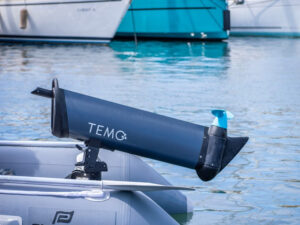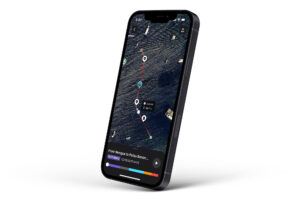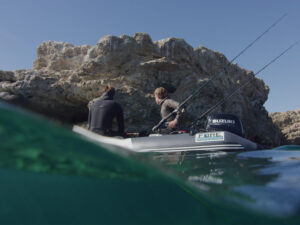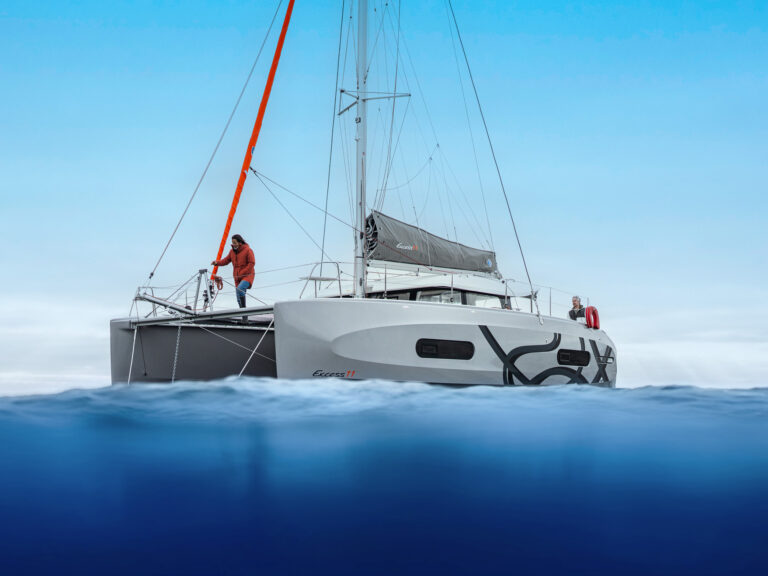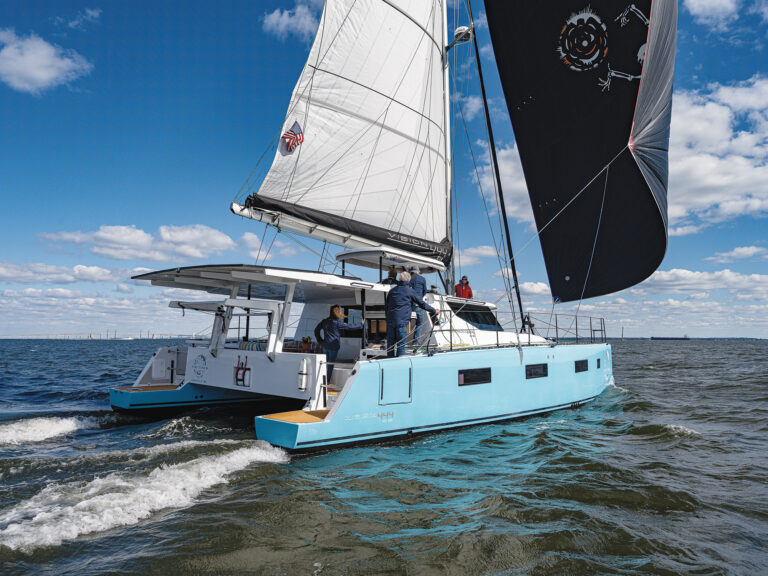
Navico SonicHub
I’m so old that I remember building a custom rack so our collection of 8-track tapes was handy to the car stereo we’d installed on our wooden sloop in the early 1970s. Having tunes at sea and in remote anchorages was sweet, but the cartridges tended to fail in a snarl of Mylar, the player itself slowly succumbed to salt air, and eventually even the format went extinct. Cassettes held up better, and CDs better still, but neither remotely compares to today’s digital storage devices as an efficient medium for enriching your cruising with music, audio books, podcasts, and even videos. You can step aboard with months of entertainment in one pocket, a backup in the other, and the original material safely tucked away at home. And now there’s a choice of stereos designed not only to manage and play your onboard library well but also to hold up in a marine environment.
Fusion Audio, a relatively new company based in New Zealand, arguably spearheaded the advent of truly modern marine stereos a few years ago, with the introduction of its MS IP500. It was built to IPx5 waterproof standards, had large controls and a big display that were easy to use and see even while under way in a fresh breeze, and it supported up to four zones of speakers and rugged single-cable remotes. Plus it had sailboat-friendly power-efficient Class D amplification; I’ve measured less than 10 watts of drain in normal use and only 12 when pumping bottom-heavy reggae through four Fusion 5- and 9-inch waterproof speakers.
But the highlight of Fusion’s original design was the ability to slip almost any model of Apple iPod or iPhone into a built-in dock where it remained safe and charged while you could quickly search and play by artists and albums using the Fusion’s controls. And note here that the audio quality available from Apple’s USB docking port is better than what you get just using the headphone jack.
Fusion’s current high-end model, the IP600

Somewhat oddly, though, it’s Fusion’s newer economy stereo, the compact RA200
For instance, the RA200’s receiver has a VHF band (as well as the standard FM and AM bands and the ability to control a black-box Sirius Satellite radio), and Fusion built in controls so you can scan favorite channels. It’s also the first Fusion with a USB port. That means you can listen to a memory stick full of MP3 audio files or access, control, and charge an undocked iPod or iPhone using its standard USB cable instead of using one of Fusion’s waterproof docks. But you may want to spring for the advanced MS-DKIPUSB dock ($100) because besides both interior and exterior memory-stick ports, it sports an RCA video port. Fusion, you see, has figured out how to output the movies, TV shows, vidcasts, and so forth that you can collect via iTunes.
The SonicHub ($350) from Navico is actually a black-box version of the Fusion RA200 with an NMEA 2000 connection that lets a Simrad or Lowrance multifunction display become your entertainment control head. It might make a traditional navigator wince, but I enjoy being able to browse my iPod playlists and watch video content using a bright, 12-inch color screen at the helm.
The SonicHub can also be operated with a Fusion wired remote when you don’t want to have an M.F.D. running, but note that both it and the RA200 use about 50 percent more power than Fusion’s 600 series because Class D amplification was left out for economy. Then again, Fusion has just announced a refresh of its entire marine stereo line, and I’ve added some details to the end of this column.

Poly Planar’s MRD80i
While Fusion may have been the first to tightly mix iPods with marine stereos, this once-sleepy niche has woken up to this and other integrations made possible by modern consumer electronics. Poly Planar, for instance, has added the MRD80i, priced at $300, to its well-regarded line of purpose-built marine audio components. This stereo has a sliding-drawer dock that includes both a USB cable and a headset jack so that it can accommodate most any portable audio player or smartphone. The design also means that there’s no need for the individual device sleeves that Fusion uses, which may need replacement if you get a new size of iPod or iPhone. The MRD80i supports audio on SD cards and USB sticks, and though it doesn’t claim Class D amplification, it was nearly as power efficient in my testing as Fusion’s D models. The Poly Planar unit also has more buttons than Fusion models, which means that a user has direct access to more functions, even if the controls are necessarily smaller. More details of my Fusion and Poly Planar testing are available in my _Cruising World_ blog entries.
While I haven’t tested a Clarion marine stereo on my own boat, I’ve often seen them installed on high-end offshore center-console fishing machines, which is quite a credit to their durability. In fact. I won’t forget seeing a Clarion CMV1

Sony, too, has an iPod-friendly marine stereo, the CDX-H910UI

_Belkin’s Bluetooth Music Receiver
_
Of course, you can simply plug a cable with headset jacks at both ends into the auxiliary input that’s common on most marine stereos, but there are some less awkward possibilities because some iPods, such as the Touch, and almost all smartphones support Bluetooth stereo streaming. It’s meant for headsets but can be used in other ways. For instance, I know sailors who are happily using little devices like the Belkin Bluetooth Music Receiver

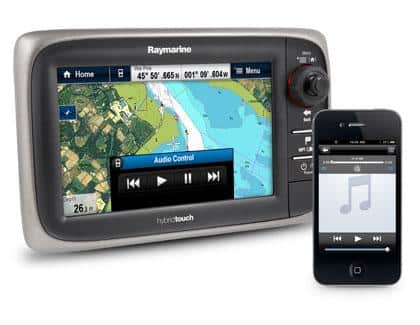
Raymarine e7 plotter
This same concept takes quite a different form in the MR F300 BT
These days, digital audio and video files are so versatile and portable that they can play on devices you might not expect, and they don’t even have to be physically brought from home. The new CPN multifunction displays from Standard Horizon, for example, are designed to play files on memory sticks when the displays aren’t in use for navigation, and they can even stream audio and video if their built-in WiFi radio is connected to a fast access point. Speaking of which, consider the L.E.D.-backlit M261VP
Obviously, the wildly changing world of consumer electronics is making itself useful to the cruising world, and I’m hoping that Fusion will again show us how to smartly fuse the two. I understand that the new** MS-IP700** ($450) coming out this winter not only has the VHF, USB, and iTunes video abilities of the RA200 but also a bright color screen capable of flipping through cover art and optional large-screen remotes that easily install on a NMEA 2000 network. The IP700 and its DVD-playing sibling, the AV700, will also have an Ethernet port that can be used in two interesting ways. If it’s plugged into a boat’s WiFi router, then an Apple device that isn’t living in the Fusion dock—many boats have more than one these days—can be used as a wireless remote. But it might also be plugged into a boat’s M.F.D. network, since Fusion is offering licenses to all the major manufacturers that permit them to integrate full AV control onto their screens, and several are purportedly working on it. Sounds good!
Marine entertainment is undergoing a revolution mainly because portable players capable of holding immense libraries of digital content have become inexpensive, easy-to-use, and, thus, nearly ubiquitous. But I’ll close with a twist on a personal audio option that you likely don’t know about yet. I’m so old now that I wear a pair of tiny Phonak hearing aids that not only let me enjoy the sounds of seabirds and boat stereos better than I have for years but can also be connected via Bluetooth to my smartphone. I can be puttering away anywhere on my boat and still take hand’s-free calls or listen to whatever I’ve stored on the phone or can stream over cellular—which means just about anything. I like to say that I’m not just aided; I’m abetted.
Ben Ellison is CW’s electronics editor.


